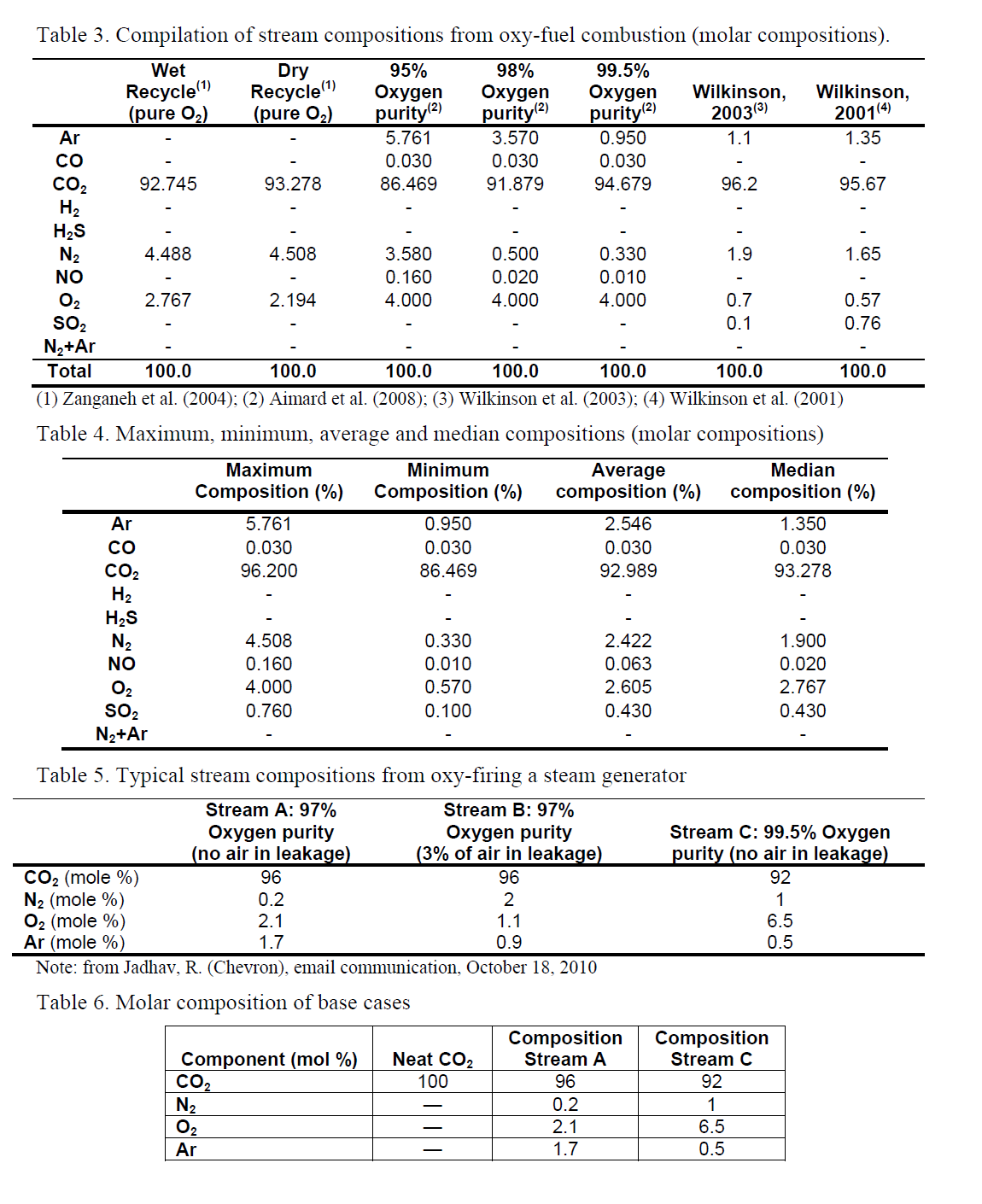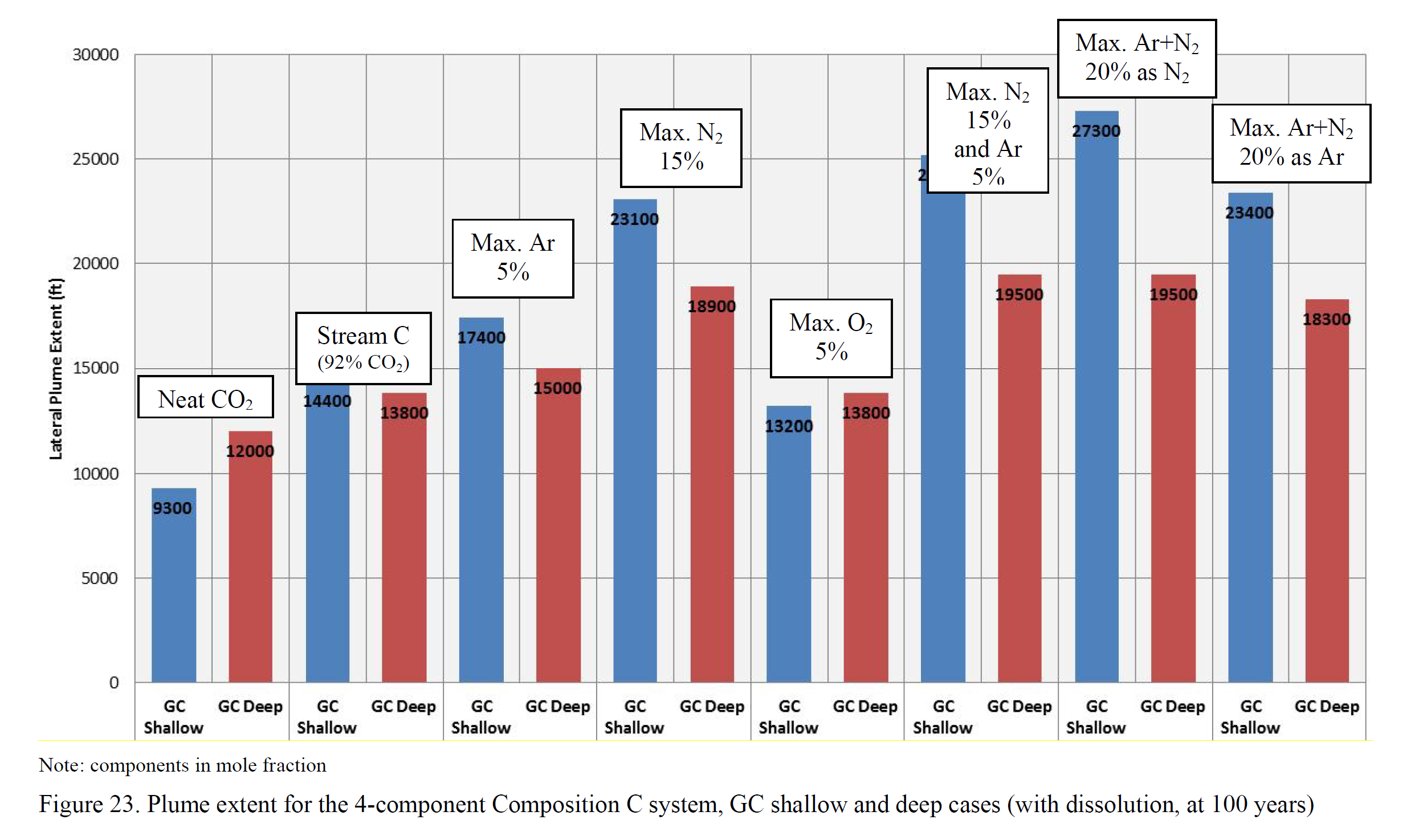Impact of CO2 Impurities on Storage Performance and Assurance
该研究旨在探究N2、O2和Ar等杂质(可能还有CH4等常见杂质,通常以饱和水平存在于地下)对CO2羽流动力学、注入能力和容量的影响。研究考虑了N2体积15%、O2体积5%和Ar体积5%的情况。但未考虑CO、H2和SOx等其他气体,这些气体的摩尔分数可能并不可忽略。为了使用精确的PVT数据(Peng-Robinson EOS),在研究初期进行了实验室实验,以获得混合物的粘度和密度。CMG-GEM依赖于多种经验混合规则进行密度和粘度计算,这些规则需要进行校准和调整。同时,通过对文献进行广泛调查,收集了关于这些不同混合物成分在不同地下压力、温度和盐度条件下的溶解性信息。气体成分在水相中的分配差异会对气相组成产生影响。本研究提出的工作是更大研究的一部分,该研究还包括杂质的地球化学影响(气体成分与其他成分和矿物的反应活性),但这方面在此处未进行处理。总体而言,地球化学过程可能会影响近场性质,如注入能力和井完整性,而对较大尺度区域的影响可以通过对羽流动力学的理解来研究。一个重要的观察是,与相同温度和压力下的纯CO2相比,混合物的粘度和密度较低。同样需要注意的是,随着深度的增加,混合物与纯CO2之间的粘度和密度对比逐渐减小。
宾夕法尼亚州立大学能源与矿产工程系
Executive Summary.
The goal of this study was to understand the impact of impurities (mostly N2, O2, and Ar, to which might be added CH4, commonly present to saturation levels in the subsurface) on CO2 plume dynamics, injectivity, and capacity. The study considered up to 15% volume for N2, 5% volume for O2, and 5% volume for Ar. Other gases such as CO, H2, and SOx, which could have non-negligible mole fractions, are not considered in the study. The problem is approached through an extended desktop study using the numerical modeling tool (multiphase flow code CMG-GEM). In order to work with accurate PVT data (Peng-Robinson EOS), laboratory experiments were performed early in the study to access viscosity and density of the mixtures. CMG-GEM relies on many empirical mixing rules for density and viscosity calculations that need to be calibrated and tuned. In parallel, a comprehensive literature survey was undertaken to collect information on solubility of those various mixture components into the aqueous phase under various subsurface pressure, temperature, and salinity conditions. The differential partitioning of gas components in the aqueous phase impacts the gas phase composition. The work presented in this document is part of a larger study that includes geochemical impact of impurities (reactivity of gas components with other components and with minerals), an aspect not treated here. Overall, geochemical processes could affect near-field properties such as injectivity and well integrity whereas larger-scale regional impacts can be studied through an understanding of plume dynamics. An important observation controlling all the results of the study is that viscosity and density of mixtures are lower than that of neat CO2 at identical temperature and pressure. Equally important to note, viscosity and density contrast between mixtures and neat CO2 decreases with depth.
The numerical models used grow in complexity from simple box-like generic models, to which heterogeneity is added in a second step, to more realistic models constructed from two actual U.S. Gulf Coast Region locations (clastic sediments) and from a Canadian (Alberta) carbonate formation but representative of many sites around the world. The objective was to reproduce end-members of aquifer architecture such as (1) clean homogeneous, medium permeability sand; (2) homogeneous sand/clay, and (3) heterogeneous sand with discontinuous shale partings and continuous baffles. Progressively more complex systems, binary, ternary, and beyond, were investigated. The results are normalized with respect to corresponding neat CO2 case and draw on two key metrics, time to hit the top and maximum extent, are contrasted for 2 depths “shallow” (~5,000 ft, ~60ºC, 2500 psi, 100,000 mg/L) and “deep“ (~10,000 ft, 125ºC, 4500 psi, 180,000 mg/L). Because O2, N2, and Ar have similar properties and behavior, they impact the CO2-dominated mixtures in a similar way, particularly at the concentration level of a couple percent molar and they can be merged in one unique component with properties of N2. However, the approximation deviates from the “true case” beyond a few percents. Impurities impact density and viscosity of the CO2-rich mixture. A lower density impacts CO2 capacity not only because of the smaller fraction injected and space needed for storing impurities but also because of the generally lower density of the impurities at the same conditions. An approximate proxy for capacity change owing to impurities is given by the density ratio. The loss in capacity can be as high as >50% at very shallow depths (~3000 ft, CO2 and 15% molar N2) but the difference quickly decreases with depth. Similarly, mass injectivity, that can be represented by the proxy metric of density over viscosity ratio, also shows a decreased value at very shallow depths that quickly recovers with increasing depth.
In terms of plume shape and extent, the impact of impurities is again more marked at shallow depth where the contrast in density and viscosity with neat CO2 is the largest. It decreases with depth. For example, about 4% mole fraction in a binary system suffices to increase plume length in “shallow” low-dip sloping layers by 25% whereas 9 to 15%, depending on the component, are needed in a “deep” system. In all cases, plume extent is greater with impurities however residual trapping occurs faster. This relationship mostly holds for all systems whatever the level of heterogeneity and complexity. The contrast is most extreme in very simple systems and heterogeneity assuming adequate operational choices seems to dampen impacts of impurities. This presumably occurs because heterogeneity creates multiple tongues blunting the impact of impurities.
It also suggests a trade-off between plume extent (area of review with risk of CO2 leakage) and decreased risk owing to faster trapping. A larger plume translates into a larger area to inspect for leakage pathways such as faults and abandoned wells but a faster trapping translates into a shorter period of time to monitor the site.






